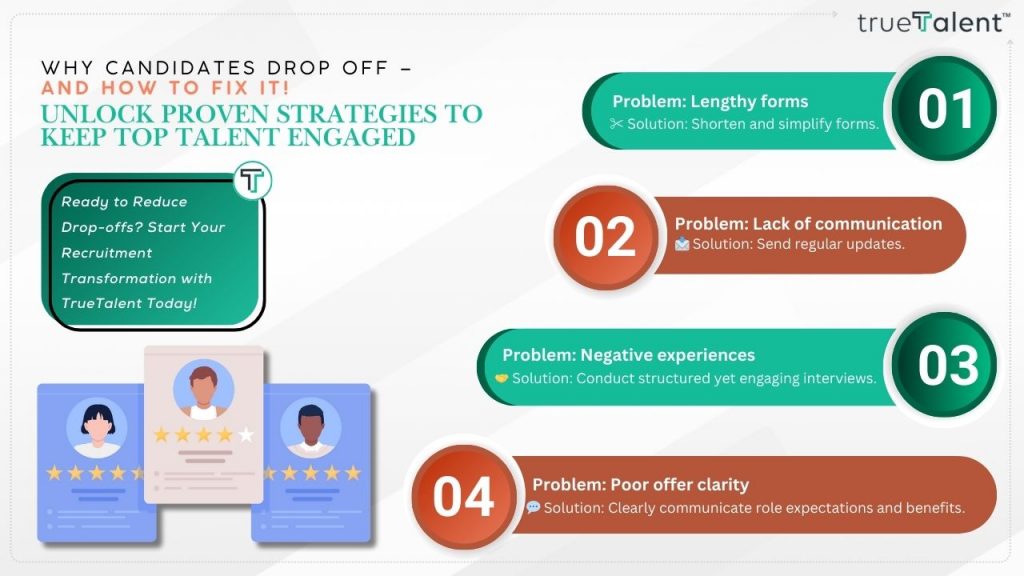
Recruitment is an intricate process for recruiters and job seekers alike. Yet, one persistent challenge remains for HR professionals and hiring managers—candidate drop-offs. These occur when promising candidates disengage or leave the hiring process altogether, often leaving companies scrambling to fill key roles and job seekers with lingering frustrations.
But why do candidates drop off, and how can we fix it? This blog will explore the common causes of candidate drop-offs, their impact, and actionable strategies to solve this problem, ensuring a smoother recruitment process for both businesses and job seekers.
Understanding Candidate Drop-offs
What Are Candidate Drop-offs?
Candidate drop-offs refer to instances where job applicants exit a recruitment process before its completion. This can happen at several stages, from the application form being abandoned mid-way to candidates declining offers after final interviews.
Common Reasons for Candidate Drop-offs
To address this challenge, it’s crucial to identify the causes. Here are the most common reasons why candidates disengage from a hiring process:
- Lengthy and Complicated Application Processes: 60% of job seekers abandon applications that feel too cumbersome or time-consuming.
- Poor Communication: Lack of updates or unclear timelines leave candidates frustrated and disinterested.
- Unrealistic Expectations or Mismatched Roles: A poorly outlined job description or unclear expectations can deter candidates mid-process.
- Negative Interview Experiences: A rude interviewer or an overly grilling interview process can discourage candidates.
- Uncompetitive Offers: Salary, benefits, or work environment falling short of expectations discourages candidates from proceeding.
Key Stages in the Process Where Drop-offs Occur
Candidate drop-offs can happen at several stages, but the following are most common:
- Application Submission: Lengthy forms or technical glitches lead to early-stage exits.
- After Initial Screening: Lack of communication or insufficient role clarity discourages interest.
- During Interviews: Candidates face an unstructured or misaligned process that undermines interest.
- Post-Offer Stage: A mismatch in expectations or better opportunities lead to declined offers.
The Impact of Candidate Drop-offs
On Businesses
Candidate drop-offs result in:
- Extended time-to-hire, delaying operations requiring new staff.
- Higher recruitment costs and wasted resources on unsuccessful candidates.
- A negative employer reputation due to disengaged and dissatisfied candidates sharing their experiences.
On Job Seekers
For candidates, drop-offs can mean:
- Disillusionment with the hiring company, and possibly the recruitment process as a whole.
- Missed opportunities that could have aligned with their long-term career goals.
Strategies to Reduce Candidate Drop-offs
Successfully addressing candidate drop-offs can be transformational for your hiring processes. Here are actionable strategies to reduce drop-offs and improve recruitment outcomes.
1. Streamline the Application Process
A clunky application system is a major deterrent.
- Shorten application forms by focusing only on key candidate information.
- Optimize forms for mobile devices to accommodate on-the-go applicants.
- Use autofill functionalities for candidate ease.
2. Enhance Communication with Candidates
Transparency and regular updates are essential to keep candidates engaged.
- Send confirmation emails after submission and post-screening.
- Provide timelines for each stage of the process to set expectations.
- Offer feedback, even to rejected applicants, to retain a positive experience for future recruitment opportunities.
3. Utilize Recruitment Technology
Smart tools make the hiring process seamless and engaging.
- Applicant Tracking Systems (ATS) like TrueTalent keep candidates informed with real-time updates.
- AI-driven tools can personalize job descriptions and communications, creating a tailored experience.
- Automation tools reduce delays between steps, maintaining candidate interest.
Best Practices in Candidate Engagement
1. Use Personalized Communication
Tailor all candidate interactions—emails, calls, and interview invites—to show potential hires that they’re valued. Small gestures, such as addressing candidates by name or referencing specific aspects of their applications, create a positive impression.
2. Leverage Social Media Platforms
Connect with candidates where they spend their time—on platforms like LinkedIn, Twitter, or Instagram. Share branded content about your workplace culture, job openings, and key company values to build stronger relationships.
3. Conduct Engaging Interviews
Ensure interviewers are trained to conduct professional, inclusive, and positive interactions to leave candidates with a favorable impression of your organization. Provide structured yet conversational interviews that elicit genuine responses while making candidates feel at ease.
Case Studies and Success Stories
Company A: A Simplified Hiring Journey
A growing tech startup reduced candidate drop-offs by implementing an AI-powered ATS. The tool streamlined their application process, shortened response times, and enabled automated follow-ups. This resulted in a 40% decrease in drop-offs and an improved candidate experience.
Company B: Enhancing Engagement Through Transparency
A retail giant revamped its hiring practices by providing candidates with real-time updates via mobile alerts. Transparency improved brand trust, and drop-offs were reduced by 50%.
Tools and Technologies to Enhance Recruitment
Several advanced tools can help minimize candidate drop-offs and improve the hiring process for both businesses and job seekers:
- TrueTalent:
- For recruiters, it provides AI-powered talent search, candidate profile insights, and hiring analytics.
- For job seekers, it offers real-time application tracking, personalized job recommendations, and insightful recruiter feedback.
- Other Tools:
- LinkedIn Talent Solutions for sourcing top talent.
- Greenhouse for streamlining recruitment workflows.
- Zoom and Teams for seamless virtual interviews.
Boost Your Recruitment Success Today
Candidate drop-offs are inevitable but manageable with the right strategies and tools. To retain the best talent:
- Simplify application processes.
- Offer strong communication throughout the hiring process.
- Leverage advanced technology like TrueTalent to create a seamless and engaging recruitment experience.
The recruitment process should be as rewarding for candidates as it is for businesses. By prioritizing transparency, efficiency, and engagement, HR professionals and recruitment managers can significantly reduce candidate drop-offs and build better teams.
Start optimizing your recruitment process today with tools like TrueTalent, and experience the difference.
